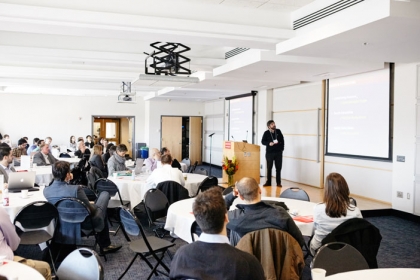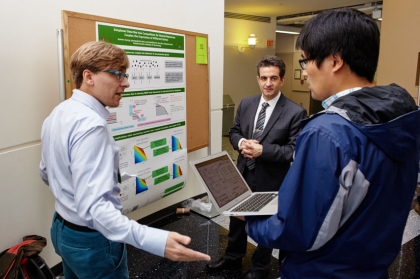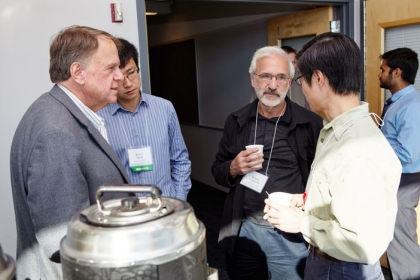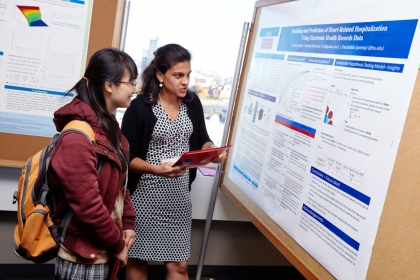Category: Events
Lectures in China
Professor Paschalidis will be visiting China in mid July 2018 to deliver a semi-plenary talk at the 2018 MTNS Conference and invited seminars at the Shanghai Jia Tong University (SJTU flyer) and the Huazhong University of Science and Technology.
NSF, CISE Look to the Future of Smart Healthcare at Campus Workshop
By Sara Cody
As the National Science Foundation looks to the future of science in smart and connected health, the agency partnered with the Center for Information and Systems Engineering to convene a gathering of principal investigators and other research leaders on the BU campus this month. The interdisciplinary researchers discussed their progress and identified new areas for future research.

“The meeting looked at cutting-edge innovations, from smart analytics to bring about personalized health solutions, to devices and algorithms that close the loop and control important physiological variables, and to ways in which we, as humans, can better interface with technology to improve our health,” said Professor Ioannis Paschalidis (ECE, BME, SE), who spearheaded the event steering committee along with Professor Christos Cassandras (ECE, SE) and Professor William Adams (MED). “It was an honor and a privilege to host this event at Boston University, welcoming many distinguished colleagues, and showcasing the important interdisciplinary work we have been doing in this fascinating arena.”
The three-day program interspersed presentations with breakout sessions in which attendees gathered together in smaller groups to discuss new ideas and presented their findings to the entire group. Presentations covered themes in connected healthcare, big data and analysis, harnessing the power of the Internet of Things to personalize healthcare, and the challenges associated with handling privacy and implementation. The first day of the workshop, titled “Visioning,” hosted a forum of more than 60 research leaders.
“The goal of this workshop is to have brilliant people weigh in about where smart health should go, and the material we gain from that will be pulled together to publish and present to NSF leadership in order to keep moving that needle,” said Wendy Nilsen, director of the NSF’s Smart and Connected Health program. “We are focused on using science to solve problems with societal value and we are calling on this community we built to come together and look to the future.”
Professor Edward Damiano (BME) presented the iLetTM bionic pancreas as an example of a smart and connected health system that “closes the loop” by automating the dosing process to treat type 1 diabetes, relieving patients and their caretakers of the burdensome task. Motivated by his infant son David’s diagnosis, Damiano has spent the last 15 years developing the bionic pancreas. The technology optimizes blood sugar levels by using dosing algorithms to automatically calculate and precisely dispense two hormones every five minutes: insulin when blood sugar levels are high; and glucagon when they are low.
“With this disease data changes every day, minute to minute, person to person. It is a day and night disease that requires round the clock care and a lot of impractical cognitive input and the current tools are failing patients,” said Damiano. “The iLetTMlearns from your ever-changing glucose needs, making 288 decisions every day, which amounts to once every five minutes, and adjusting the medication as subtly or dramatically as the patient requires.”

The Principal Investigator meeting was held on the second day and brought together more than 120 researchers representing more than $150 million NSF investment in smart and connected health. In addition to summarizing the previous day, the meeting featured 84 ignite talks — 90-second research overviews summarizing interesting insights and hopes for the future of smart connected health.
“The Smart and Connected Health Visioning and PI meetings were remarkable for their collaborative focus on the future,” said Nilsen. “Participants, supported by the multidisciplinary environment at BU, envisioned future scientific needs through the lens of fundamental and applied sciences to identify the prime potential areas of research.”
Tsinghua University partners with the BU Division of Systems Engineering
 In the current spirit of promoting scientific and educational collaborations across departments, campuses, and universities, Boston University has reached out transnationally by signing a significant agreement on Friday, May 6, 2016 with Tsinghua University, Beijing, China for the establishment of a dual degree program. The agreement was signed by Boston University President, Dr. Robert A. Brown and Tsinghua President, Dr. Qiu Yong.
In the current spirit of promoting scientific and educational collaborations across departments, campuses, and universities, Boston University has reached out transnationally by signing a significant agreement on Friday, May 6, 2016 with Tsinghua University, Beijing, China for the establishment of a dual degree program. The agreement was signed by Boston University President, Dr. Robert A. Brown and Tsinghua President, Dr. Qiu Yong.
The College of Engineering, in particular, the Division of Systems Engineering, initiated the discussions with Tsinghua, with Dean Kenneth Lutchen of the College of Engineering, Professor Christos Cassandras, Head of the Division of Systems Engineering, and Hua Wang, Associate Head of the Division of Systems Engineering leading negotiations on behalf of Boston University.
“Tsinghua University is one of the premier universities in China with well-established educational and research activities in Systems Engineering. Several members of the Center for Information and Systems Engineering (CISE) and the Division of Systems Engineering, have existing collaborations with Tsinghua faculty members. We expect that this agreement will build on those existing collaborative relationships by further advancing joint graduate degree programs, as well as strengthen research collaborations involving faculty and students,” stated Professor Cassandras.

Designed by the Department of Automation at Tsinghua and the Division of Systems Engineering, the dual degree program will attract exceptional undergraduate students from Tsinghua to the M.S. program in Systems Engineering at Boston University. In some cases, admitted students completing two semesters of course work at BU will return to Tsinghua and complete a final practicum requirement in Beijing. Professor Hua Wang, enthusiastic about the new program, stated that “with this agreement, we not only can enhance our research collaborations with our colleagues at Tsinghua, but we are particularly excited to work with Tsinghua students selected through a rigorous evaluation and admissions process. We have designed a curriculum featuring the best courses and projects to take advantage of the synergistic relationship between the two institutions. This collaboration will add an exciting dimension to the academic programs of both sides.”
A previous collaboration with China was established in October 2014 when BU signed an agreement with Zhejiang University, setting a precedent for a successful international collaboration with a Chinese institution of higher education. That agreement was spearheaded by Professor Ioannis Paschalidis, Director of the Center for Information and Systems Engineering (CISE) and established a framework of cooperation between the College of Engineering at BU through CISE and the Faculty of Information Technology at Zhejiang through its State Key Laboratory of Industrial Control Technology.
Workshop: Control and Observability of Network Dynamics, April 11-15, 2016
John Ballieul was an organizer for the Control and Observability of Network Dynamics workshop at the Mathematical Biosciences Institute at The Ohio State University, Ohio, which brought together many well known people in the control field. Yannis Paschalidis (CISE director) presented a paper at this workshop.
CISE Hosts International Symposium on Control of Network Systems
Attendees Celebrate New IEEE Journal Edited by ENG’s Paschalidis
By Mark Dwortzan

Professor Christos Cassandras (ECE, SE) describing a strategy to maximize battery lifetimes in wireless sensor networks at SCONES, held October 27-28 in the Photonics Center Colloquium Room (Photos by Dave Green)
Microbes are all around us—even inside us—and that’s a good thing. Left alone, these tiny organisms have a huge impact on everything from human health to wastewater treatment. But with a little engineering, they could do even more. In certain environments, their metabolic processes could be exploited to make biofuels, vaccines and other useful products and services. To tap their potential,Associate Professor Daniel Segrè (Biology, BME, Bioinformatics) and collaborators have developed mathematical models to predict the metabolic interactions that occur among different microbial species under varying environmental conditions, and to design new microbial networks with desired properties.
Segrè presented his research at the first Symposium on the Control of Network Systems (SCONES), held on October 27-28 in the Photonics Center Colloquium Room.
Sponsored by the IEEE Control Systems Societyand the Center for Information and Systems Engineering at Boston University, SCONES celebrated the inaugural March 2014 issue of theIEEE Transactions on Control of Network Systems (TCNS), a new IEEE Transactions journal edited by Professor Yannis Paschalidis (ECE, BME, SE) focused on problems related to the control, design, study, engineering, optimization and emerging behavior of network systems.
“We live in a world that is extremely interconnected,” said Paschalidis, the journal’s editor-in-chief. “This is also true of systems, biological or manmade, that support our modern way of life. Networks, which both connect system components and influence how they function as a whole, are increasingly the focus of leading edge research, and this is the impetus forTCNS and SCONES.”

TCNS Editor-in-Chief Professor Yannis Paschalidis (ECE, SE, BME) (center) with MIT PhD student Andras Gyorgy (left) and another SCONES participant (right) during a poster session.
One author of each paper in the inaugural issue presented at the symposium, along with talks and posters from several other researchers in the field. Representing major research institutions from around the world, SCONES presenters explored the analysis, control and optimization of electric power, computer, communication, transportation, biological, cyber-physical, social and economic networks. As if bringing the TCNS journal to life, the 23 featured speakers illustrated complex concepts with a flurry of equations, algorithms, graphs and diagrams.
“TCNS aspires to become the premiere destination for mathematically rigorous work in network systems,” said Magnus Egerstedt, an ECE Professor at Georgia Tech and the TCNS deputy editor-in-chief—and the SCONES presenters lived up to that promise.
In addition to Segrè, two other Boston University researchers shared highlights of papers they co-authored in the inaugural issue of TCNS on resource allocation and routing, the selection of optimal path by which to transmit information across the nodes of a network.
Professor Lev Levitin (ECE, SE) presented an alternative to wormhole routing, a widely used routing technique that’s prone to deadlock—multiple messages getting blocked by one another in a vicious cycle—under heavy computer network traffic. Levitin described a series of new, high-performance algorithms that he, Professor Mark Karpovsky (ECE) and ECE Visiting Researcher Mehmet Mustafa developed to break such cycles and prevent deadlock formation during routing and thus preserve network connectivity.

Professor Michael Caramanis (ME, SE) (second from right), who chaired the symposium’s first session on control and optimization of electric power networks, with University of Maryland Professor John Baras (ECE) (left), BU Systems Engineering PhD student Bowen Zhang (second from left) and California Institute of Technology Professor Steven Low (ECE) (right) during a break.
Professor Christos Cassandras (ECE, SE) presented an optimal control strategy that he, Tao Wang (SE, PhD’13) and Sepideh Pourazarm (SE, PhD candidate) devised to maximize the lifetime of sensor batteries deployed at each node of a wireless sensor network for surveillance, environmental monitoring or other applications where human intervention may be inconvenient or costly.
“Because every node has limited energy, you have to worry about the battery dying and the network ceasing to function,” said Cassandras, “so you need to focus on battery lifetime.”
Modeling each battery as a dynamic system in which energy does not dissipate in a linear fashion, the strategy uses an algorithm to determine the routing scheme that will minimize that energy loss.
The symposium, which was well-attended and featured many fruitful exchanges between speakers and attendees, signified how well the TCNS journal has been received by the international research community, Paschalidis observed.
“In the first three TCNS issues published in 2014, we have seen papers covering many types of network systems, from networked control and multi-agent systems, to communication, transportation, electric power, biological and social networks,” he noted. “SCONES is playing a key role in coalescing a community of researchers around the journal.”

